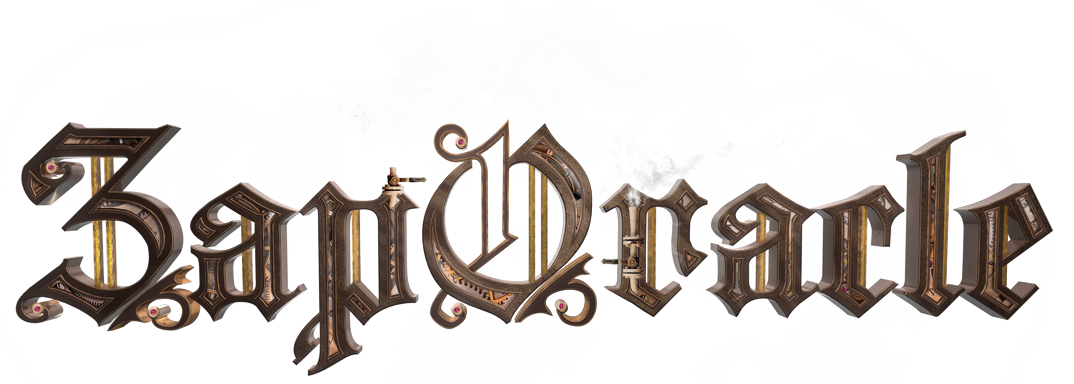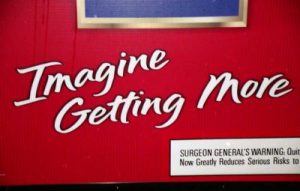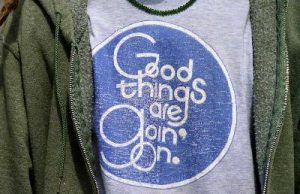One of the most potent of spells or enchantments that can bind you into the matrix is to live under the compulsion of always having to imagine getting more in the future. Under this spell, you become a donkey forever hypnotized by an imaginary carrot just up ahead. The carrot, the “more”, that ever glitters in your mind’s eye like a ring of power, could be many things—–sex, money, power, fame, looks—-often the imagined more is a vision of that more perfected life just up ahead, the one in which you have realized your ideal weight, made your first hundred million, and have an amazing lover with whom you live in a house featured in Architectural Review… The phrase in the cigarette ad— “Imagine getting more…”—- is meant to encourage you in the profitable belief that cigarette smoking leads to getting more sex. The warning label, black and white and boxed in, reminds the alert mind that what you will be getting more of is cancer. What you get more of when your eyes are bedazzled by the imaginary carrot just up ahead is more cancer of the soul. Your vision, your consciousness, is misdirected away from the present moment where it could have more power and life right now.
Most people on the planet experience scarcity in one or more key areas of their lives. Some scarcities are related to needs and others to wants. Common areas of perceived scarcity include money, physical resources, social status, youth, looks, sex, physical health, fulfilling relationships, inner resources, and meaningfulness. Most lives involve strange and tense combinations of scarcity and abundance. For example, a tan and sleek billionaire walking off the tennis court might be dying of a famine of meaningfulness. Our vision of scarcity is often highly distorted and one-sided. Perceived scarcities range from delusory toxic wants to what would be genuinely fulfilling if we had more of it.
Scarcity comparisons with other people are almost always unreliable and highly distorted. Typically we compare our area of most irritating scarcity with someone else who seems to have that area filled to overflowing. We never look at the whole portfolio of scarcity and abundance in the other’s incarnation. We can’t look at it, we’d have to know how their whole life turned out. We see tall, handsome Christopher Reeve galloping on his thoroughbred horse, we don’t necessarily see up ahead where he gets tossed to the ground a quadriplegic and goes through a life phase of horrendous scarcities as he becomes more soulful and compassionate and discovers new forms of fulfillment.
“Imagine getting more” and “envious comparison” are intertwined spells that bind us into neurotic suffering. These spells promise fulfillment in the future but create hollowness in the present.
Hollowness is the mindset of the ringwraith as it withers the present while it forever reaches toward that glittering precious just up ahead. Hollowness is the state of one who forever reaches toward the future to be filled up.
Don’t wither the vitality of the present by looking at it with the eyes of scarcity and victimhood. All too easily you can build a reality tunnel defined by your view of the present as the time of scarcity before you have an abundance of money, or before you have the perfect lover, the perfect body…whatever you covet getting more of. This is the time that counts right now, this time with its strange and tense combination of scarcity and unrecognized abundance, the time that gives you everything you need to work with in the present moment. Break the spells, become disenchanted and more powerful, work with what you got right now.
See Kill the Time Grid and Fire up your Life
Before we get into some ways to deal with the negative thoughts and feelings that afflict so many people, we need to know what does make people happier and to understand that we must first quickly reveal the secret of life:
(from my Guide to the Perplexed Interdimensional Traveler)
The Secret of Life
In the Sixties, aspiring young travelers set out to “look for the meaning of life.” Unfortunately, as someone once pointed out, they got the question backwards, because it is life that asks you in a challenging tone: “What is your meaning?” and you had better be able to supply the answer. Meaningfulness is what we need far more than survival; and anyway, as Don Juan put it, “There are no survivors on this earth.” Or, as a wise older man once told me, “Don’t do anything you won’t remember well on your death bed.” — a razor-sharp way to cut out the trivia and superficialities to get at the meaningful marrow of life. Concentration camp survivor/existential psychologist Victor Frankel created a whole school of psychology (Logotherapy) based on the innate drive for meaningfulness. The ones who could psychologically/spiritually survive the camps, Frankel observed first hand, were the few who could find meaningfulness in their experience. A frequent theme reported by those who have had transcendent near-death experiences is a revelation of a deep and unexpected meaningfulness in even the mosaic of small, seemingly unconnected experiences of life. Also revealed during many NDEs and other mystical epiphanies is that this plane of existence is something like a school where we signed on for extremely challenging learning experiences. (See Life Lessons from the Living Dead) This brings me to what I believe are the two sides of the “Secret of Life” magic coin. The first side is self-development — to grow, develop, evolve, become more self-aware and conscious in every way possible. This innate will toward self-development was apparent in you even when you floated in the dimension of the womb-world. The other side of the magic coin is to help others, especially with their development. There it is, both sides of the secret of life. And notice that, unlike so many other things in life, this magic coin is always available. But don’t take my word for it, go to the East and seek out a guru (who will probably hit on you and want you to sweep up around the ashram for twenty years), do whatever you have to do, but this is the secret of life that works for me and feels solid. I would also like to point out that the life stance I am espousing here in this guide, is not my original fabrication (much though my narcissism might want to take credit for it), but is largely based on my thirty-year study and practical application of the I Ching, the five-to-six- thousand-year-old Book of Changes, on which Taoism (and much of Eastern philosophy, martial arts, medicine and culture) is based. And the I Ching doesn’t want you to have faith in it (uncritical belief) or doubt, but recommends an open, neutral stance. Take what resonates with your inner truth sense, what works for you, and leave the rest. Returning to the two sides of our secret of life coin, notice that self-development and helping others are two sides of a single, integrated whole. But the first side, self-development, is the foundation, and it is only by developing yourself that you have the option and capability to help others with their development. In fact, from the point of view of the I Ching, you have only one obligation in life, which is to get your relationship to yourself right. Fulfill that obligation and your relationships to others, to time, money, sex, power, food, mortality, career, politics, and the universe will all take care of themselves. But neglect or distort any part of your relationship to yourself and all these other relationships will accordingly be distorted and diminished.
Inner Independence
At the heart of healthful relationship to yourself is a stance known as “inner independence.” You (but not necessarily your ego) are the center of your own vortex, your own ever-changing equilibrium. Whenever you fall into dependence — grasping for Precious like an obsessed Ring Wraith, your center collapses and you become an enslaved puppet of the Babylon Matrix. A classic example of this is grasping for the “hottie” — that all attractive person out there burning holes in your mind like Sauron’s one ring to bind them all. Quentin Crisp put it this way: “The consuming desire of most human beings is deliberately to plant their whole life in the hands of some other person. I would describe this method of searching for happiness as immature. Development of character consists solely in moving toward self-sufficiency.” Codependence or inner independence? The first step on the path of seeking another to complete you is a supreme betrayal (the betrayal of your own soul) so don’t be surprised if betrayal remains a central theme of that path.
The Inner Marriage of Yin and Yang
Getting your relationship to yourself right means working to evolve the inner marriage of yin and yang, feminine and masculine within yourself. Get that right and as a whole person you have the ability to have spiritually transforming, life-affirming relationships. Look to another person to complete you, however, and you become a wraith forever grasping for a Precious that forever eludes your grasp. And of course Precious doesn’t have to be a Hottie, it can be consumer goods, money, power, career, or whatever the Babylon Matrix can tempt you with that you believe you can’t live without. But I particularly mention the Hottie because this ravenous craving, which most of us know so well, is a pillar of the Babylon Matrix. In Plato’s Symposium, Aristophanes states that before we were in our present, gender-specific bodies we were spherical beings containing both genders. Jealous gods, wishing to punish and disempower us, fractured our spherical bodies so that we would lose touch with our androgynous inner wholeness. In this weakened state, we were easily conditioned to follow gender stereotypes which reinforced the ravenous delusion that we needed sexual/romantic union with others to complete ourselves. Break the power of that ancient ruling ring (which in the darkness binds you) and you reclaim your own center of power, self-actualization and ability to love others as a whole person. For more on this theme see: Stop the Hottie!, Casting Precious into the Cracks of Doom—Androgyny, Alchemy, Evolution and the One Ring, Lessons for an Entity Incarnating as a Mammal, and No Tristans Allowed Beyond this Point—Debunking the Western Myth of Romantic Love.
Meeting Halfway — The Touchstone for Relationship
At the center of relating well to others, cautiously moving outward from your center of inner independence, is the I Ching principle of meeting halfway (Hexagram 44). Less than halfway would be, for example, to neglect others to whom we are connected by inner ties. More than halfway would be, for example, giving unasked for advice, proselytizing, self-important intervening, lifeguarding others, etc. So if you go to a party and see someone you’re attracted to, but you’re so shy that you hide in a corner and never approach him or her, then you have met less than halfway. Hitting on him or her (without some obvious encouragement from the other) would be meeting way more than halfway. Even in the course of a conversation one needs to apply this principle of meeting halfway by keeping attuned to the moment, aware of the subtle minutiae of openings and closing in the other person. With the openings we advance, with the closings we retreat and yield space. When the other transgresses, invades boundaries or comes at us with false personality, we should never go along with it, should never do anything that compromises our inner dignity. We should withdraw energy from the person who is coming from their false self. This can mean anything from breaking eye contact (a withdrawal of energy), ending the conversation, or in some cases, going our own way for a lifetime. When we do withdraw we should do so lovingly, giving the other space to come to his senses on his own. We do not, in I Ching terms, “execute” this person in our minds, which would be to view him as hopeless and unable to improve. This would only help to keep him imprisoned by doubt. We also don’t indulge excessive optimism that assumes he will become more conscious in this lifetime, or that extends trust where it is being abused. We step back to allow the creative to take its zigzag course. And for our own sake, as well as the other, we try not to carry ongoing grudges against someone. From the I Ching point of view, we are responsible not only for what we say or do to the other, but also for our thoughts, because these are communicated on the inner plane.
Psychic Filters and Inner Voices
Speaking of our thoughts, we need to watch them constantly. We need to recognize that different voices, often generated by distinct subpersonalities, speak in our heads, and we need a central, witness personality that observes those voices/subpersonalities without becoming them. Hexagram 27 reminds us not to nourish ourselves on negative, unnourishing thoughts and fantasies. Yes, that’s easier said than done, but here are a couple of psychic filters to keep online that are guaranteed to catch all the psychic allergens (the negative thought forms) that all too easily pervade our inner world. We’ll call the first of these the “tone filter.” As you listen to the voices of your inner world (or the voices in your outer, interpersonal world) refuse to believe any voices that aren’t calm, compassionate and centered. Listen to them, understand where they are coming from, but don’t become them, don’t identify with them or believe them. If a voice is nagging, carping, bitter, mechanically repetitious, whining, angry, self-pitying, hypercritical, etc. then it is not to be believed! By tone, you can easily distinguish the voices of false subpersonalities and the still, deep voice of the Self.
Gerund Filter
A second filter involves a list of categories of thought that are indicative of the ego nervously trying to control the Tao. The position of Taoism (based on the I Ching) is that the universe is unfolding as it should. But the ego, like a nervous backseat driver clutching an imaginary steering wheel in its sweaty, white-knuckled grip, never trusts the nonlinear path of the creative so completely out of its control. Categories (presented as a list of gerunds) that indicate the ego resisting the Tao and/or trying to assert imaginary control over it include: WANTING, WISHING, WORRYING, HOPING, FEARING, DREADING, DESIRING, ENVYING, COMPARING, SUPERVISING, LIFE-GUARDING, JUDGING, COMPLAINING, SELF-PITYING, STRIVING, ANTICIPATING, EXPECTING, PRESTRUCTURING, CONTRIVING, FORCING PROGRESS, HEDGING, RATIONALIZING, CLINGING AND DOUBTING. Yes, this is an intimidating list! It is an embarrassing revelation of just how often we default to the ego dominating our psyches.
Next, we’ll get into some of the nuts and bolts of how to change patterns of thought and the afflictive emotions that ride into town with them.
Emotional Alchemy, Dealing with Afflictive Thoughts and Feelings
Earlier I promised that we would get more into the nuts and bolts of how to deal with negative thoughtforms and the afflictive emotions associated with them. The most comprehensive and effective approach I’ve found is in a marvelous book entitled Emotional Alchemy by Tara Bennett-Goleman. Tara, a Zen Buddhist psychotherapist, and her husband, Daniel Goleman, wrote the best-selling book entitled Emotional Intelligence. They’ve also collaborated with the Dali Lama on a book about overcoming afflictive emotions. If you like this approach, I would certainly suggest reading Emotional Alchemy, which is now available in paperback at almost any large bookstore. The book is rather repetitive, however, and in a few pages I can probably tell you 80% of what’s in it. The Golemans bring together Buddhist psychology, cognitive psychology and some recent findings from neuroscience into their groundbreaking work on afflictive emotions. “Afflictive emotions” is a Buddhist term that describes a general phenomenon that most of us are all too familiar with — the suffering, the affliction of negative emotions. There is nothing new about this problem, but it has also never been timelier with depression and anxiety disorders dramatically on the rise in the West, particularly in the U.S.
Through a synthesis of the three disciplines mentioned above (neuroscience, cognitive psychology and Buddhist psychology), we’ll examine how afflictive emotions work and how they gain hold and easily dominate our inner experience. Then we will discuss the alchemy part, how to transform our relationship with afflictive emotions through methods that can dramatically reduce suffering. (I can testify from my own personal experience to the effectiveness of this method.)
Neurological Materialism
Part of the reason that afflictive emotions are so virulent, and so hard to change, may have to do with our neural architecture. I say “may” because neurology is in its infancy and has never been able to successfully explain the association of consciousness and the brain. A terrible delusion which I’ve written about elsewhere, and which I wish the Golemans had acknowledged, is the philosophical and pseudoscientific position known as “neurological materialism.” A neurological materialist believes that consciousness (if they admit consciousness exists at all — many don’t) is an epiphenomenon (a secondary effect) of biochemical processes in the brain. Neurological materialism dominates the psychology departments of most colleges and universities in the U.S., and many ordinary citizens have picked up on this and taken it as a given, proven by “science.” But it has not been proven by science, quite the contrary. There is much scientific evidence pointing away from neurological materialism. Part of the problem is that in the “soft” sciences of biology and psychology, many have not been able to integrate the findings of quantum mechanics and are still pretending to do science while inhabiting an archaic Newtonian universe where everything is governed by causality. Physicists like Danah Zohar, Roger Penrose, Amit Goswami and Fred Alan Wolfe have proposed quantum mechanical models in which neurological process is a correlate, an analog, an acausal parallelism to a consciousness that is hyperspatial, nonlocal, not “in” the brain. Those who have had OBEs (out-of-body experiences—I’ve had numerous) and NDEs have experienced that consciousness can exist outside the body and is actually greatly enhanced by being out of the body. (For a highly detailed case history of an NDE that is inexplicable via neurological materialism see: Life Lessons form the Living Dead.)
Neural Architecture and The Emotional Body
You do not, however, have to buy into the fallacy of neurological materialism to recognize that neurological realities — such as neurotransmitter levels and neural architecture — are huge players in human experience. So after this long disclaimer about neurological materialism, let’s take a look at what neuroscience can tell us about afflictive emotions.
The Low-Resolution Amygdala
Now that we have the technology to do real-time body imaging of live people, scientists are able to map out activity levels of different brain structures moment-by-moment. What’s been observed is that when people are exposed to an emotional trigger event, the amygdala, a brain structure somewhere behind the frontal lobes, goes “hot.” When a strong emotional response is aroused, the amygdala lights up on the computer screen as its metabolism intensifies. Neuroscientists believe that the amygdala evolved as an environmental threat-detection monitor. They believe that it stores threat patterns (such as snakes, spiders, fire, predators) and when a trigger event occurs, when something is perceived in the environment that matches or seems to match these patterns, the amygdala turns on and triggers fight-or-flight readiness throughout the body. The amygdala, however, is no rocket scientist; its pattern recognition ability is primitive and low resolution. As a survival strategy, it’s safer to get a lot of false positives rather than to miss a single actual hazard. Better for a scaredy-cat (a domestic cat with overly strong startle reflex) to jump away from imaginary hazards than to miss one car. (The big cats I used to work for at the Prairie Wind Wild Refuge didn’t have this type of startle reflex because no one sneaks up on a six hundred pound tiger…) So, for example, an animal or person could have a powerful startle response to, say, a piece of rope dangling from a branch at the edge of peripheral vision that the speedy but imprecise amygdala may read as a dangerous snake. Also, to put the amygdala in the context of neural architecture, it has strong neuronal connections to the neocortex in human beings. This may explain how the amygdala, which is fast but low-resolution in its discriminations, can easily dominate our higher thinking, which has higher resolution but much slower reaction time. Therefore we experience a second or two when we actually think we’ve seen a snake until our neocortex can reassert itself and reinterpret the sensory information with higher resolution discrimination. It is also believed by neuroscientists that in this phase of evolution, where most human beings are more threatened by emotional trauma in early childhood than by snakes or fire, patterns of emotional trauma are now what is primarily stored in the amygdala.
Schemas: Stereotyped Patterns of Emotional Reactivity
Following that glimpse at the amygdala from neuroscience, we switch to cognitive psychology, which holds that there are classic, stereotyped patterns of emotional reactivity known as “schemas.” These schemas (and here you would do well to go to Emotional Alchemy, where they are individually discussed) include very familiar afflictions such as: abandonment fear, low self-esteem, deprivation and entitlement. When trigger events occur, these engrained patterns of emotional reactivity take over and we typically have disproportionate, inaccurate, stereotyped responses, while the higher resolution discrimination and more reflective aspects of higher thinking are overridden by an intense emotional funk.
Trigger Events And Storylines
Let me ground this approach in a specific example. Our case involves a young woman, an office worker, who was raised by narcissistic, rather unloving parents. As a consequence of her early childhood experience, she is especially governed emotionally by the deprivation schema with generous helpings of the low self-esteem and abandonment schemas thrown in. One of her coworkers goes out on a coffee run for everyone and when he returns, as a random accident, her coffee was forgotten. This minor accident is a trigger event for her deprivation schema. Almost instantly, in less than a quarter of a second, her amygdala lights up and catalyzes a cascade of pronounced physiological changes — her face flushes as capillaries dilate, heart rate increases, body temperature elevates and breathing becomes fast and shallow. The amygdala sends strong signals to her neocortex causing her thinking to fall into line with disproportionate, inaccurate, stereotyped thoughtforms that coalesce into a storyline which helps to perpetuate the trauma and reinforce the schema: They forgot mine on purpose. I’m always left out. No one ever gives me my fair share. I knew they didn’t like me. He’s just like my father… This funk could continue for hours, or continue almost perpetually in the background, especially as internal perturbations — traumatic memories, negative thoughtforms and fantasies—are internally generated as trigger events that perpetuate the misery.
The Law of Dependent Causation
Buddhist psychology now comes into play with suggested methods of self-liberation from afflictive emotions. The Buddhists have a concept variously translated as the law of “dependent origination” or “dependent arising.” There is a chain of dependent, causally related events that creates the suffering of afflictive emotions. In the case of the schema attack described above, we have trigger event linked to neurological response linked to physiological response linked to cognitive response (the storyline). Break any part of this chain and you can break the whole cycle.
Breaking Inner Tape Loops with Numbers Exercises
An elegantly simple method to break the cognitive link involves occupying your mind with simple numbers exercises. This method is not in Emotional Alchemy, and these particular numbers exercises come from a book of psychological techniques and exercises designed to support a Gurdjieffian approach to consciousness. Use this method especially when you find that your mind is “looping” — playing the same negative storyline tapes again and again — “he said, she said” etc. When you focus your mind on the numbers exercises, you will stop the looping, stop the storylines stone cold dead in their well-worn tracks. True, numbers exercises may not be very entertaining, but I’ll take nonentertainment over looping storylines that create the suffering of afflictive emotion and thereby degrade bodily health as well. The first numbers exercise is to count up by 2s from 1, and down by 2s from 100 in an alternating sequence: 1, 3, 100, 98, 5, 7, 96, 94, 9, 11, 92, 90, 13, 15, 88, 86, Etc. This gets a little tricky when the two streams of numbers cross, but you’ll find that you get into a rhythm with it and it gets a lot easier with practice. Your mind will want to default back to storylines, daydreams or other distractions, and if it succeeds, it will break the numbers exercise at which point you just pick it up again, from the beginning if necessary. The second numbers exercise is much easier and can be done partly on autopilot which presents a great temptation for your attention to wander and for you to lose track of the numbers. It’s designed that way to train you to maintain focus, to have power over the default mechanism that wants to switch you back to storylines, daydreams, etc. It also trains you to divide attention, as you can easily do this exercise while doing laundry, driving, manual chores, etc. This time you count up by twos in an ascending/descending sequence that keeps growing like a ladder that you climb up and down while adding a new rung with each ascent. The top number is always repeated and is 2 higher than the last top number. It looks like this: 1 3 3 1 1 3 5 5 31 1 3 5 7 7 5 3 1 1 3 5 7 9 9 7 5 3 1 1 3 5 7 9 11 11 9 7 5 3 1 Etc. One more part of this easy sequence is that whenever you hit the number 11, coming up or down the ladder, you do some sort of bodily movement — snapping your fingers, blinking an eye, etc. You’re doing well with this exercise if you can make it into the 70s without losing the number stream by defaulting into tape loops or daydreams. Like push-ups and sit-ups, numbers exercises may not always be fun, but they are an effective and direct way to become stronger.
Heisenberg’s Uncertainty Principle And Self-Observation
Now we’ll return to the Emotional Alchemy approach that centers on the Buddhist practice of mindfulness. I’ve been practicing mindfulness techniques for years and have found them to be very effective in everything from dealing with bodily pain (mindfulness pain management), every day tasks and even getting more enjoyment out of eating food. We know from physics (Heisenberg Uncertainty Principle) that to observe a thing is to change a thing. The maximal case of this effect is when the human psyche is observing itself.
Mindfulness Pain Management
Mindfulness involves sustained investigative awareness, a persistent witness consciously observing what’s going on (inner and/or outer) with great moment by moment presence. To practice mindfulness pain management I focus in on the pain sensations. The pain I feel in my recently dislocated thumb seems to radiate outward in pulsing concentric waves from the center of the knuckle. I observe and map out its periodicity, its ebb and flow, when it is peaking and when it is subsiding. I don’t shrink from it, I welcome it into perception and carefully observe its modulations. When I do this it becomes an interesting energetic phenomenon happening in my perceptual universe. Emotional funks and negative thoughtforms can also be studied with this careful, impersonal observation.
Mindful Self-Observation
When I hear a voice speak in my head I can welcome it into my perceptual field, the inner theater of my mind, and ask it to step into the spotlight of attention and show me who it is and what it really wants. By mindfully observing the emotions and storylines, we cannot be identified with them. We become an outside witness to them, so they cannot think us, as they did to the young woman office worker in her schema attack. You can observe them with a cool, neutral, compassionate stance. Instead of shrinking from them, welcome them into attentional space. The metaphor I’ve used for myself is that I am a butterfly collector in the Amazon, where a rare, interesting butterfly has flown into my net. Aha, here’s a live one I can study. As you work with this practice you will find that your mindfulness will have less discontinuities and you will catch schema attacks sooner. At the early phase of the practice you might notice that you had a schema attack after it’s over. Why did I get into that silly argument? Oh, I see, it was my deprivation schema triggered when she said… Another time you might catch a schema attack while it’s happening, while the butterfly is in the net. If it is happening just internally (not an interpersonal argument) you can observe without direct interference and learn something about what type of schemas you have and what type of subpersonalities come forward to speak for them. See how long the schema attack lasts. When does it peak? When does it start to taper off? What was the trigger event? How is your body being affected — breathing, muscle contractions, etc?. After you have felt that you’ve sufficiently studied who the voices are and what they want, you can choose in a later stage of the practice to actively intervene. The numbers exercise is one way to do that. The frightening-looking deities seen outside of some Buddhist temples are supposed to be entities of “wrathful compassion.” At this phase of the practice you can be wrathfully compassionate and intervene with a ferocious act of will. I used to visualize a glowing magical sword hovering above an old reel-to-reel tape recorder I used to have, the moving reels of tape playing the annoying thoughtforms. When I summoned my will the sword would come slicing down into the tape, cutting it in two so that the reels would begin to spin quickly in opposite directions. Another visualization I’ve used comes from the first two Lord of the Rings movies where we see Gandalf facing down the Balrog on the Bridge of Kazadum. I see Gandalf activating his staff and luminescent sword, Glamdring, and saying with all his might, “You cannot pass. I am a servant of the secret fire… You cannot pass.” A simpler technique I recently came up with that seems quite effective is that when I notice my mind picking up a dumb tape loop I just say to myself in the tone of an irate, protective mother watching her two-year-old pick up a dog turd and begin to put it in his mouth, DROP IT!!! DROP IT!!!!! Get creative and use whatever works for you.
The Magic Quarter Second
Finally, if you really want to go for the Olympic level of this practice, you will try to derail a schema attack in what neuroscientists call “the magic quarter second.” If you were able to recognize that a trigger event is catalyzing your amygdala to launch a schema attack in the first quarter second, before it has gained a physiological hold on you, then you could knock it off its tracks, nip it in the bud before it can do any damage at all. Usually you don’t know if a trigger event is coming. But in some cases you do, let’s say you have to make a phone call to that difficult parent or problem person you know is likely to trigger you. I had a great opportunity to try the Olympic version when I was canvassing for a wildlife refuge. In certain yuppie neighborhoods I knew there was a high probability of getting a nasty response. As a former, recovering New Yorker, who was also a school teacher for fourteen years, six in the South Bronx, my whole being is conditioned for the high-speed come back. I might have needed that skill back then, but when canvassing, such a reaction can get you and your organization into trouble. So what I would do is ring the bell, take a couple of deep breaths, center myself in my body and wait like a tennis player for the ball to come across the net and a golden opportunity to catch the magic quarter second. But even though I knew the trigger event was coming I often couldn’t help but to react anyway. It should go without saying that what you especially don’t want is to allow a schema attack to control your actions, decisions or spoken words. There is a well-known Samurai story where the Samurai has a duty to assassinate the assassin who killed his master. Methodically he stalks the assassin and at the right moment approaches with drawn sword. The assassin spits on him. The Samurai sheaths his swords and walks away. The idea is that he became emotionally agitated when he was spit on and now if he used his sword it would no longer be a pure, impersonal act. Words are often swords. When we are emotionally agitated we should sheath our tongues and hold back from actions and decisions.
Awakening from Depression (from Zap Oracle card # 305)
“Happiness does not depend on outward things, but on the way we see them.”
— Tolstoy
Subclinical depression is almost the norm in our society. Many people go through their days burdened, their gaze lowered, suffering under a generalized feeling of oppression. Although it is easy to attribute much of this to fractured, alienated lives, environmental toxins and poor diet, research indicates that the primary causes are negative thought forms, often occurring just beneath conscious awareness, which frame perception negatively so that one lives in a darkened reality tunnel. For example, “Life sucks, and then you die…I never get my fair share…I can’t do anything right…” etc. The negative thought forms trigger negative emotions that in turn trigger physiological changes, and the process feeds on itself as a vicious circle. This card indicates that this is a propitious time for you or someone close to you to awaken from depression. There are many ways to go about the awakening, but the will has to be there for recovery to occur. Depression is a yin condition, associated with lowered energy and a murky wateriness. Take deep breaths, stand up straight with good posture and get going, get active, raise fire, the yang principle, by doing useful stuff! Don’t feel like it? Excellent, that is the sure sign of how well getting active will work. Start simple and pick tasks that give definite results — cleaning up your home, for example. Shift to a high vitality diet with more live and raw food. Do a fearless moral inventory and ask yourself what you will remember well on your deathbed and prioritize doing that.
Depression is often suffering that is neglected and not confronted. For this reason, I prefer anguish and the dark night of the soul because these are more dynamic states capable of transformation. Confront what haunts you.
Zap Oracle links that can help if you are feeling down:
Could you be addicted to pain? See: Rebelling from the Pain Body Matrix Are you unhappy about being in your body? This is the core of much neurotic torment and takes the form of dissatisfaction with looks/weight/aging/health. Read: The Glorified Body Are you unhappy about romantic relationships? Read: Challenging Thoughts on Love Stop the Hottie! Casting Precious… Having trouble finding a path of meaning and creativity in your life? Much depression is caused by a deficit of meaningfulness. Read: The Path of the Numinous For more on discovering the core meaning of your life and facing some of the tough existential realities of human incarnation read: The Capsule of Intentionality… and read all parts of A Guide to the Perplexed Interdimensional Traveler If your depression is related to a devastating loss or shock, the last part of the guide, “Dealing with Shock,” will address that directly. Worries have you down? Read: An Antidote to Worry Feel like there’s something wrong with this entire plane of existence? Read: A Splinter in your Mind Want an effective life stance that will hold up to the darkest moments? Consider the path of the warrior: The Way of the Warrior Warrior Quotes The Taoist Path Taoist Quotes Finally, if you’ve looked into all these other possibilities and feel that an outside force is depressing you, read the documents in the mind parasite category of the writing section or order a copy of the Mind Parasite Matrix. Use these resources and summon your will to awaken from depression!
Dealing with Psychic Entropy (from Zap Oracle Card 550)
Psychic or psychological entropy is a state of mind first written about by Carl Jung and later developed by Mihály Csíkszentmihályi in his concept of Flow. A state of psychic entropy is characterized by anxiety, sadness and boredom and typically includes looping negative thought tapes. Psychic entropy is a state that leaves us hampered in our ability to deal with complex external tasks or useful inner contemplation. We all know what this feels like — that all too familiar state of being frazzled, fragmented and unraveled, paralyzed by inertia and self-conflict, worried thoughts gnawing our mind like a chew toy. So what can we do about that?
One answer is to use such times to do easy mechanical tasks like laundry and dishes that can be done even if your attention is a bit fragmented. Entertaining, not too dense audiobooks and podcasts on headphones can be a way to fill the chaotic inner space with better quality content. Psychic entropy is more likely to occur in solitude so if there is a positive social interaction available you can try that. Focus on external considering — on others’ needs rather than your own — as psychic entropy is based on internal considering. Alternatively, you could go all the way in the other direction and sit down in solitude, perhaps with a journal open, and carefully observe, or even record, all the fragmenting thoughts as they loop through your mind and see what subpersonalities they come from and what their issues are. If the state of psychic entropy comes from a general deficit of meaning in your life then see what you can do to increase meaningfulness.
Consider Csikszentmihalyi’s “5 C’s” of a Complex Personality as summarized by Maryam:
“The Complex Personality knows how to integrate a variety of experiences into its overall experience, making the dullest moments interesting. Being in Flow leads to Complexity for when you experience Flow, you want to experience more of it and construct your world to pull you irresistibly towards experiences within the Flow. Focus on these to craft your world:
1) Clarity – Know what you want to do in your life every day. Have clarity of goals, listen to feedback and adjust yourself to the feedback you receive from the world.
2) Center – You are in Balance. Your goal is to focus, to know how to avoid distractions, to become at one with what you’re doing, with all of your attention under your control.
3) Choice – Knowing there are a variety of possibilities around you, that you’re not determined by outside events but have choice and can move within it. Whatever you do, you do “at Choice”.
4) Commitment- Care for what you’re doing at all times. Remain conscious of what you care about. Commit to it.
5) Challenge – Keep upping your challenges as you master a certain level. Always make life more challenging.”
Working through a Glass Darkly — Adapting to the Difficult Conditions of the Babylon Matrix (from Zap Oracle card #570)
Often we set standards and expectations for ourselves that would be more realistic if we lived in a world redesigned by our egos where the first law of thermodynamics tended toward efficiency instead of entropy. Many of us apply standards of perfectionism to ourselves, our lives and others, that do not take into account the often darkly distorted and backward conditions of the Babylon Matrix. When you do take those conditions into account, you may find perfectionism replaced by compassion.
For example, whenever I plan out how long a certain chore or project will take, I have found that it often takes two to four times longer than I think it will. When I attempt to plan, I put on my ego’s glasses. With my ego’s glasses on, the fisheye, backward, darkling distortions of the Babylon Matrix flatten out into a chessboard-like landscape. The ego sees how it can checkmate the chore or project in three or four moves. Through the ego’s glasses, I conveniently forget to see the dark, distorting fields of the Babylon Matrix, the laws of mechanical resistance, the strange and sometimes chilling winds blowing through my psyche, and through the whole species, so that we make our moves quite often against the wind, and in a landscape where gravity is unstable, and the blowing sheets of rain are laced with psychoactive substances altering our moods and perceptions. And when you make your moves against the wind, in a landscape where gravity is unstable, and the blowing sheets of rain are laced with psychoactive substances altering our moods and perceptions, then you will find that many chores and projects take two to four times longer than you thought they would when you were wearing ego glasses that saw the world as a nice, neat chessboard.
My point is neither complaint nor discouragement, quite the opposite. We learn and develop more in the Babylon Matrix than we would in a chessboard world. Also, it is encouraging to realize that we may be doing better than we think we are given the conditions that we labor under. For example, we may marvel at the wonderful novel or painting or invention someone made. But if you read his biography you may often marvel all the more at how he got anything done, even taking out the trash, given the problems and conditions he labored under. Look again at Van Gogh’s <a href=”http://www.moodbook.com/wallpapers/vincent-van-gogh-wallpaper-starry-night.jpg”><i>Starry Night</i></a>, and as you gaze at its cosmic magnificence, try to also hold in your mind the horrendous life conditions Vincent labored under, his strong genetic tendency toward bipolar disorder, the failure to sell any paintings to anyone but his brother while he lived, his woefully deficient diet, and so forth and so on, and see if the star of <i>Starry Night</i> doesn’t seem to glow even brighter in your mind as you realize the darkened sky under which he labored.
The night before I wrote this card, I had ended the evening feeling like I wasn’t getting enough done, and went to this oracle and the I Ching looking for answers. The oracles didn’t seem to cooperate with my agenda. I was in a self-help mode; I wanted the five steps to an effective and efficient life, but the Zap Oracle was emphasizing the shadow aspects of life. In the “What to prioritize…” place I drew the card “Beautiful Friendship,” yet I had been thinking that key relationships were what was getting in the way of my accomplishment. The I Ching gave me “Inner Truth” and “Difficulty at the Beginning.” Not satisfied with what seemed to be oblique answers, I attempted some dream seeding, inviting my unconscious to manifest dreams that might address my questions about efficiency and effectiveness. In the dream that followed this request, I am a new recruit in a kind of boot camp. I’m aware in the dream that I am fifty-one (my age in the waking life), but I know that everyone else in boot camp is struggling too, and no one is going to want to hear about my age or how special I think I am. My attitude in the dream is one of modest acceptance and diligence. During the basic training session — and it seems we are in what appears to be a school classroom rather than an outdoor training field — we are told that a psychoanalytic program is available to us that takes about forty-two years. When I awoke from the dream, I realized that I’m about thirty-one years into that program in the waking life, so I have about eleven years to go. Now that I know what’s involved much better than I did when I was twenty, I realize that those will have to be eleven very highly developmental years indeed if I’m going to finish so soon. The message from the unconscious, in response to the questions from my ego about how to live my life more effectively and efficiently, was that life is like a cross between boot camp and a classroom, and the psychological development part of the program, if you choose to engage it, is a bit more than the expected ten weeks of boot camp, about forty-two years more. Also, rather than complaining about these conditions, my focus needs to be on modest acceptance and diligence.
Also last night, during the same hour when I was resisting what seemed like oblique answers from the oracle, I was skimming the news via internet and a few sentences in a news story about obesity in women caught my attention. I had an uncanny sense that those few sentences contained a more direct answer to my questions about efficiency and effectiveness. Here’s what I read:
“Inappropriate restraint was a third major factor tied to women with excess weight in both of these recent studies. Restraint seems to have two different faces, since it has been linked with lower calorie consumption and lower weight, but also with weight gain and overweight. The European study of middle-aged women adds important insight by differentiating between the two types of restraint. Rigid restraint involves strict eating rules and a downside that it may promote binge eating once you break a rule. It was linked with greater short-term weight loss, but after two years was unrelated to weight. However, flexible restraint, a habit of moderate self-regulation and compensation for occasional high-calorie choices, was one of the strongest predictors of weight loss at two years.
“To encourage flexible restraint while avoiding overly rigid rules, experts urge us to create stable eating habits to meet nutritional and hunger needs without fostering a sense of deprivation. The Center for Mindful Eating recommends mindful eating that honors our food and our body’s hunger signals, portions that make sense and attitudes free of depriving rules and unrealistic expectations.” Source: “The Reasons We Eat”
In other words, under the difficult conditions of being an obese middle-aged woman trying to lose weight, perfectionism was counterproductive, and a more realistic, tolerant, flexible approach to discipline was effective. Working through the difficult conditions of the Babylon Matrix, in general, is helped by letting go of perfectionism and creating stable, flexible habits of discipline that you can live with. You allow for slip-ups and compensate for them rather than punishing yourself or trying to tighten the screws of control.
Last night I also went to sleep early, and set an alarm, even though it was a day off, for six hours later. Often I only need six hours of sleep, but this morning I found myself turning off the alarm and sleeping for an additional three hours. I woke up feeling discouraged that I slept so long, but I also realized that it was in the three hours after the alarm that I had the dream. I also found that I felt incredibly well rested and that I was in just the right state to write this card. The flexibility to sleep longer seemed to have worked out.A couple of years ago, I was feeling really discouraged about the same efficiency/effectiveness issues and tackled the problem in an all-day writing session that became an essay entitled <a href=”http://www.zaporacle.com/textpattern/article/115/mechanical-resistance-matrix”>”Mechanical Resistance Matrix”</a>. In the course of writing this essay, I consulted with the I Ching which helped me to enumerate principles for dealing with a mechanically resistant matrix. Those principles paralleled what I found in the news story last night, and added a few more principles like attention to detail. I recommend reading that essay if this card seems relevant to you. Also extremely relevant are Path Finding/Day Mapping and other documents in the Warrior Stance section of Zap Oracle.
Consider this a propitious time to heal the way you work through a glass darkly.
Finally, let’s end on a positive, proniac note ( from Zap Oracle Card # 305)
Pronoia/ Good Things are Going on
Good things are going on, but don’t expect to see that reflected in newspaper headlines! Our minds, adapted to a hazardous existence, nervously scan our world for signs of impending disaster. We often overlook the far greater signs of good things going on.
This is an abundant universe. Put quotation marks around the voices in your head that are endlessly worried about scarcity of money, resources, opportunities, romantic partners, etc.
Look up at a clear night’s sky and think about how much real estate is out there — ca. 100,000,000,000 stars in just our galaxy, and by some estimates 500,000,000,000 galaxies in the universe with many physicists now saying that our universe is just a tiny bubble in an ever expanding foam of multiverse. The universe has created 50,000,000,000,000 cells just to sheath you in a corporeal body for this one difficult incarnation where apparent scarcity and other hardships are part of the abundance of developmental forces.
My friend Rob Breszny wrote a book entitled Pronoia. According to the book, Pronoia is a term “…coined in the mid-1970s by Grateful Dead lyricist and cofounder of the Electronic Frontier Foundation, John Perry Barlow, who defined it as the opposite of paranoia: ‘the suspicion that the universe is a conspiracy on your behalf.’ ”
It is easy to view life as a catastrophe, a catastrophe we can head off only by a white-knuckled grip on our body, money, possessions and relationships. But maybe your life is more of a “euchatastrophe” than a catastrophe.
From Wikipedia:
Eucatastrophe is a term coined by J.R.R. Tolkien that refers to the sudden turn of events at the end of a story that result in the protagonist’s well-being. He formed the word by affixing the Greek prefix eu-, meaning good, to catastrophe, the word traditionally used in classically-inspired literary criticism to refer to the “unraveling” or conclusion of a drama’s plot. It could be said that the ending of The Lord of the Rings is a Eucatastrophe. Though victory seems assured for Sauron, the One Ring is destroyed beyond all hope. Essentially a bad situation suddenly turns good.
For more on Pronoia, go to Rob Brezsny’s site, freewillastrology.com, and/or read my review of Pronoia:
Is the World Spiraling Toward Eucatastrophe or is that just my Pronoia? The latest edition of Pronoia was available on 9-22-09.
***
There are many more key secrets of life and ways to avoid darkness and feel more fulfilled at zaporacle.com where you can find A Guide to the Perplexed Interdimensional Traveler (which is both free document and Youtube) as well as
the free 664-card Zap Oracle and hundreds of other articles and Youtubes (see Zap Oracle You Tube Channel) as well as 140 articles right here on Reality Sandwich
 ZapOracle.com home to the free 720-card Zap Oracle
ZapOracle.com home to the free 720-card Zap Oracle











